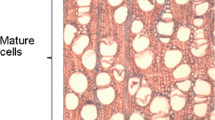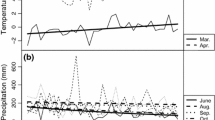Abstract
Key message
Although first flowering in trees causes clear changes in main stem morphological trends, we prove that it does not totally explain changes in wood density trends.
Abstract
The phase change produced by a tree’s first flowering event (that marks the limit between juvenile and mature stage) causes changes in the morphological trends of the main stem. As has been documented in a number of tree species, the number of growth units per annual shoot, the annual shoot length, and the growth unit length are some of the variables that exhibit abrupt changes when first flowering occurs. Considering the strong impact of first flowering on tree morphology—and considering also trends that have been observed in wood density and related variables, we tested the relationship between the first flowering event and wood density trend changes in Pinus radiata D. Don at three different site conditions with differing climates. The relationship was studied using different criteria to select the proper variables and methodology. Some interesting relationships between first flowering and certain variables were found, particularly the variables earlywood density, latewood density accumulated, latewood proportion, and ring area. However, these relationships were not consistent among the three sites. Overall, there is not enough evidence to conclude that the first flowering causes or contributes to changes in wood density trends. Our findings suggest that studies should be conducted on the relationship between the architectural development of the crown and changes in internal wood characteristics. We corroborate the suggestion as reported by Burdon et al. (For Sci 50:399–415, 2004) of adopting the terms corewood and outerwood instead of juvenile and mature wood.


Similar content being viewed by others
References
Abdel-Gadir AY, Krahmer RL (1993) Estimating the age of demarcation of juvenile and mature wood in Douglas-fir. Wood Fiber Sci 25:242–249
Alteyrac J, Cloutier A, Zhang SY (2006) Characterization of juvenile wood to mature wood transition age in black spruce (Picea mariana (Mill.) B.S.P.) at different stand densities and sampling heights. Wood Sci Technol 40:124–138. doi:10.1007/s00226-005-0047-4
Amarasekara H, Denne MP (2002) Effects of crown size on wood characteristics of Corsican pine in relation to definitions of juvenile wood, crown formed wood and core wood. Forestry 75:51–61. doi:10.1093/forestry/75.1.51
Bouffier L, Raffin A, Rozenberg P, Meredieu C, Kremer A (2009) What are the consequences of growth selection on wood density in the French maritime pine breeding programme? Tree Genetics Genomes 5:11–25. doi:10.1007/s11295-008-0165-x
Burdon RD (1994) Annual growth stages for height and diameter in Pinus radiata. New Zeal J For Sci 24:11–17
Burdon RD, Walker JCF, Megraw RA, Evans R, Cown DJ (2004) Juvenile versus mature wood: a new concept, orthogonal to corewood versus outerwood, with special reference to Pinus radiata and P. taeda. For Sci 50:399–415
Centro de Información de Recursos Naturales (1996) Estudio agrológico VI Región. Descripción de suelos materiales y símbolos. CIREN 114, CIREN, Santiago, pp 570
Clark A, Daniels RF, Jordan L (2006) Juvenile/mature wood transition in Loblolly Pine as defined by annual ring specific gravity, proportion of latewood, and microfibril angle. Wood Fiber Sci 38:292–299
Cremer KW (1992) Relations between reproductive growth and vegetative growth of Pinus radiata. For Ecol Manag 52:179–199. doi:10.1016/0378-1127(92)90501-Y
Denne MP (1988) Definition of latewood according to Mork (1928). IAWA Bulletin n.s. 10:59–62
Edopka IW, Ogbeide EM (2013) Bootstrap approach control limit for statistical quality control. Int J Eng Sci Invent 2:28–33
Fernández MP, Norero A, Barthélémy D, Vera J (2007) Morphological trends in main stem of Pinus radiata D. Don: transition between vegetative and reproductive phase. Scan J For Res 22:398–406. doi:10.1080/02827580701610261
Gapare W, Wu H, Avarquez A (2006) Genetic control of the time of transition from juvenile to mature wood in Pinus radiata D. Don. Ann For Sci 63:871–878. doi:10.1051/forest:2006070
Gaspar MJ, Louzada JL, Silva ME, Aguiar A, Almeida MH (2008) Age trends in genetic parameters of wood density components in 46 half-sibling families of Pinus pinaster. Can J For Res 38:1470–1477. doi:10.1139/X08-013
Greenwood MS (1995) Juvenility and maturation in conifers: current concepts. Tree Physiol 15:433–438. doi:10.1093/treephys/15.7-8.433
Harris JM, Cown DJ (1991) Basic wood properties. In: Kininmonth JA, Whitehouse LJ (eds) Properties and Uses of New Zealand Radiata Pine. For Res Inst, Rotorua, p 110
Heuret P, Meredieu C, Coudurier T, Courdier F, Barthélémy D (2006) Ontogenetic trends in the morphological features of main stem annual shoots of Pinus pinaster (Pinaceae). Am J Bot 93(11):1577–1587. doi:10.3732/ajb.93.11.1577
Hylen G (1999) Age trends in genetic parameters of wood density in young Norway spruce. Can J For Res 29:135–143. doi:10.1139/x98-170
Instituto Nacional de Investigación Agropecuaria (1985). Suelos volcánicos de Chile. INIA. Ministerio de Agricultura. Santiago, Chile. pp 723
Jones CS (1999) An essay on juvenility, phase change, and heteroblasty in seed plants. Int J Plant Sci 160:105–111. doi:10.1086/314215
Koubaa A, Zhang SY, Makni S (2002) Defining the transition from earlywood to latewood in Black spruce based on intra-ring wood density profiles from X-ray densitometry. Ann For Sci 59:5110–5118
Kucêra B (1994) A hypothesis relating current annual height increment to juvenile wood formation in Norway Spruce. Wood Fiber Sci 26(1):152–167
Kumar S (2002) Earlywood-Latewood demarcation criteria and their effect on genetic parameters of growth ring density components and efficiency of selection for end-of-rotation density of Radiata Pine. Silvae Genet 51:241–245
Kumar M, Saranpää P, Barnett JR, Wilkinson MJ (2009) Juvenile-mature wood transition in pine: correlation between wood properties and candidate gene expression profiles. Euphytica 166:341–355. doi:10.1007/s10681-008-9815-1
Larson PR (1969). Wood formation and the concept of wood quality. School of Forestry and Environmental Science Bulletin 74. Yale University, New Haven
Li L, Wu HX (2005) Efficiency of early selection for rotation-aged growth and wood density traits in Pinus radiata. Can J For Res 35:2019–2029. doi:10.1139/X05-134
Mäkelä A (2002) Derivation of stem taper from the pipe theory in a carbon balance framework. Tree Physiol 22:891–905
Mansfield SD, Parish R, Di Lucca M, Goudie J, Kang K-Y, Ott P (2009) Revisiting the transition between juvenile and mature wood: a comparison of fibre length, microfibril angle and relative wood density in lodgepole pine. Holzforschung 63:449–456
Meilan R (1997) Floral induction in woody perennials. New Forest 14:179–202
Panshin AJ, de Zeeuw C (1980) Textbook of Wood Technology, 4th edn. McGraw-Hill Book Co., New York
Park Y-ID, Dallaire G, Morin H (2006) A method for multiple intra-ring demarcation of coniferous trees. Ann For Sci 63:9–14. doi:10.1051/forest:2005093
Pernestal K, Jonsson B, Larsson B (1995) A simple model for density of annual rings. Wood Sci Technol 29:441–449
Prodan M, Peters R, Cox F, Real P (1997). Mensura Forestal (Forest Mensuration). Serie Investigación y Educación en Desarrollo Sostenible. Deutsche Gesellschaft für Technische Zusammenarbeit (GTZ) GmbH, Instituto Interamericano de Cooperación para la Agricultura (IICA): San José, Costa Rica. p 586
Santibáñez F, Uribe M (1993) Atlas agroclimático de Chile: regiones sexta, séptima, octava y novena. Ministerio de Agricultura, Fondo de Investigación Agropecuaria, Santiago, p 99
Sauter UH, Mutz R, Munro D (1999) Determining juvenile-mature wood transition in Scots pine using latewood density. Wood Fiber Sci 31(4):416–425
Savva Y, Koubaa A, Tremblay F, Bergeron Y (2010) Effects of radial growth, tree age, climate, and seed origin on wood density of diverse jack pine populations. Trees 24:53–65. doi:10.1007/s00468-009-0378-0
Sweet GB (1972) The effect of maturation on the growth and form of vegetative propagules of radiata pine. New Zeal J For Sci 3:191–210
Taylor W (2000) Change point analysis: a powerful new tool for detecting changes. Retrieved from http://www.variation.com/cpa/tech/changepoint.html
Tondjo K, Brancheriau L, Sabatier S-A, Kokutse AD, Akossou A, Kokou K, Fourcaud T (2014) Is the variability of key wood properties linked with the variability of key architectural traits? Case of planted Teak in Togo regarding thinning and provenance. Ann For Sci 72:717–729. doi:10.1007/s13595-014-0425-x
Zamudio F, Rozenberg P, Baetting R, Vergara A, Yañez M, Gantz C (2005) Genetic variation of wood density components in a radiata pine progeny test located in the south of Chile. Ann For Sci 62:105–114. doi:10.1051/forest:2005002
Zimmerman RH, Hackett WP, Pharis RP (1985) Hormonal aspects of phase change and precocious flowering. In: Pharis RP, Reid DM (eds) Encyclopedia of plant physiology (NS), 11. Springer-Verlag, Berlin, pp 79–115
Zobel BJ, Sprague JR (1998) Juvenile wood in forest trees. Springer, Berlin, p 300
Zobel BJ, Van Buijtenen JP (1989) Wood variation: its causes and control. Springer, Berlin, p 363
Acknowledgments
This project was financed by the Chilean National Science and Technology Commission (FONDECYT), Grant Number 11085008. We are grateful to Dr. Jennifer Grace (SCION, New Zealand) for her kind help in the revision of the ring boundary definition. We also thank Mr. Ariel Mella, private forest owner, and the Compañía Manufacturera de Papeles y Cartones (CMPC) for allowing the use of stands and trees for the study, and Isabel Rojas and Catalina Gerstmann for their support in field work. Finally we thank Prof. Alex Moreno and his staff at the Wood Prototypes Laboratory, at the Facultad de Arquitectura, Diseño y Urbanismo, Pontificia Universidad Católica de Chile, for their kind help in wood sample processing, and Joaquín Barceló for preliminar data analysis.
Author information
Authors and Affiliations
Corresponding author
Ethics declarations
Conflict of interest
The authors declare that they have no conflict of interest.
Additional information
Communicated by E. Magel.
Rights and permissions
About this article
Cite this article
Fernández, M.P., Cornejo, B. Is the first flowering event and corresponding maturity phase in trees related to radial wood density changes?. Trees 30, 859–870 (2016). https://doi.org/10.1007/s00468-015-1326-9
Received:
Revised:
Accepted:
Published:
Issue Date:
DOI: https://doi.org/10.1007/s00468-015-1326-9




